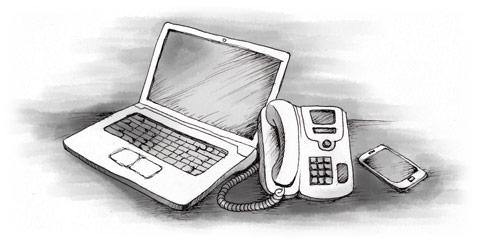Using a fixed landline (numero fijo) in Chile will require you to set up a phone plan with one of several nationwide providers. This can be done at one of their branch offices or through their website/call centre (be prepared to stand in line in the first instance, and be able to communicate exactly what you want in Spanish in any service environment in Chile). Similarly, your phone bills can be paid in branch or online, and through a local checking account if you have one
Your service provider will set your rates for domestic and international calls, but more importantly will determine the carrier code that prefixes your number.
The carrier code is used differently depending on whether you are contacting a mobile, fixed, or international number and in conjunction with the various area codes for regions and cities.
The table below presents the various combinations of dialling in as clear a manner as possible. Included is the newly implemented addition of 2 to all landlines in Chile, with the correct dialing order.
| From a landline | From a mobile |
|
| To a landline | If in the same area code: dial 2 + the standard phone number. If in a different area code: carrier code + area code + 2 + phone number. | 0 + area code + 2 + phone number (e.g. Santiago, 022 nnnnnn ) |
| To a mobile | 09 + eight-digit phone number | eight-digit phone number |
| International | carrier code + 0 + country code + area code + phone number | same as for a landline |
(‘800-’ numbers are free from fixed lines)
Mobile phones/cell phones
Major operators in Chile include Movistar, ENTEL and Claro, with testimonials alleging that Claro and ENTEL have the best geographical coverage. Whilst roaming coverage for foreign phones does exist in Chile, the best bet for anyone staying for more than the length of an average holiday is to get a unlocked international or local cell, prepaid.
All mobile products can be purchased from operator stores, both physical and website-based, and a variety of electronics stores throughout the country. Similarly, monthly bills and prepay minutes can be paid for and purchased on these sites in most cases, cutting down on some of the paper billing/payment procedure.
Payment plans are only available with:
- resident status
- an RUT number
- proof of a Chilean bank account
As in any country, getting a contract or monthly-payment phone is a lot more hassle than simply buying a prepaid SIM from one of the many vendors and keeping it topped up. Students especially are unlikely to have the means or the inclination to be tied down to a regular payment plan.
Instead anyone looking for prepaid solutions should simply purchase a cheap phone locally or bring their unlocked phone (providers in some countries block users from swapping SIMs to enforce exclusivity) from home.
Once in Chile, a SIM card from one of the major networks with a Chilean number can be purchased from electronics kiosks and phone stores (usually US$10 for the card before any minutes have been paid onto it). Minutes can be purchased at the same locations usually, and also through the companies’ websites.
Foreigners may like to use smartphones in Chile for business and leisure, and the country’s growing network of WiFi hotspots in towns and cities makes this increasingly easy. Also, given the bureaucratic nature of customer service in Chile, being able to talk to personnel whilst completing whatever procedure they are asking you to follow can minimise some of the frustration that these encounters bring.

